SWEDISH SOUTH ASIAN STUDIES NETWORK
Visit to Jadavpur University, Kolkata, Wednesday 14 December
Web page: http://www.jadavpur.edu
 In
the afternoon we made a most interesting visit to Jadavpur University,
located in south Kolkata. It was really to enter another world as we walked
into the campus meeting all the students and teachers on their way to
various activities. There were posters with all sorts of activities, seminars,
workshops, training courses, etc.
In
the afternoon we made a most interesting visit to Jadavpur University,
located in south Kolkata. It was really to enter another world as we walked
into the campus meeting all the students and teachers on their way to
various activities. There were posters with all sorts of activities, seminars,
workshops, training courses, etc.
One of the big posters was about the 50th anniversary of the University,
which was to be celebrated within short, with all sorts of cultural activities.
Jadavpur was, when it was started a technical and science university,
but due to a very conscious policy on part of its founders, a sizable
faculty of Arts and Social Sciences was also included. There is no technology
without culture, seems to have been the motto.
But there is more to the history. Already in 1905 a college named National
Institute for Education was started here and provided advanced higher
education. This later became one of the core resistance nodes in the Bengali
struggle for independence.
With such traditions and without much heavy colonial academic luggage,
Jadavpur today gives a very pleasant impression of informal interaction
and less hierarchy compared to the old Indian universities. It has about
12 000 students and a faculty measuring about 750.
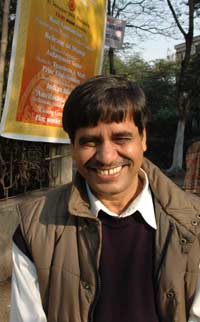 We
were hosted by Prof. Asoke
Bhattacharya, Prof. of Adult and Continuing Education (photo to
the right). A vigorous and still quite young enthusiast, he has taken
the ideas of the Danish Grundtvig about education and democracy to his
heart. He thinks segregation in society can be prevented by continued
and adult education. Since 1999 he is involved in an exchange with the
Grundtvig Institute at Göteborg University
(contact person Ingrid Lomfors) and as a
result there is now also such an institute at Jadavpur University. The
faculty is among other things involved in practical development work among
people in the South Parganas District of West Bengal, for which they have
been given the ‘UNESCO
Award for Adult Literacy.’
We
were hosted by Prof. Asoke
Bhattacharya, Prof. of Adult and Continuing Education (photo to
the right). A vigorous and still quite young enthusiast, he has taken
the ideas of the Danish Grundtvig about education and democracy to his
heart. He thinks segregation in society can be prevented by continued
and adult education. Since 1999 he is involved in an exchange with the
Grundtvig Institute at Göteborg University
(contact person Ingrid Lomfors) and as a
result there is now also such an institute at Jadavpur University. The
faculty is among other things involved in practical development work among
people in the South Parganas District of West Bengal, for which they have
been given the ‘UNESCO
Award for Adult Literacy.’
We informed Asoke about the interest for adult and continuing education
with the Ministry of Education in Bhutan and promised to send details.
It would perhaps be far more efficient and feasible for Bhutan teachers
to come down to Kolkata for interaction on this, than going straight to
Denmark or Sweden.
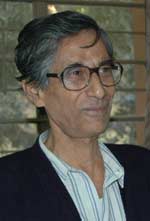 Our
first meeting was with the Vice-Chancellor, Prof. A
N Basu (photo to the left). He was well informed about ongoing
exchange and cooperation programmes with Sweden (see also below) and after
we hade reviewed these, he suggested that we should write a Memorandum
of Understanding, MoU, to consolidate the cooperation. We discussed that
and came to the conclusion, that since SASNET is just a facilitator, it
would have to be between Jadavpur and one or two universities in Sweden,
with which most of the cooperation took place. A MoU should come when
cooperation has taken on a certain size and durability.
Our
first meeting was with the Vice-Chancellor, Prof. A
N Basu (photo to the left). He was well informed about ongoing
exchange and cooperation programmes with Sweden (see also below) and after
we hade reviewed these, he suggested that we should write a Memorandum
of Understanding, MoU, to consolidate the cooperation. We discussed that
and came to the conclusion, that since SASNET is just a facilitator, it
would have to be between Jadavpur and one or two universities in Sweden,
with which most of the cooperation took place. A MoU should come when
cooperation has taken on a certain size and durability.
Next we had a meeting in the Dean’s office, Faculty of Science with:
• Professor Subrata Pal,
Dept. of Biotechnology & Dean of the Faculty of Science
• Professor D Bandyopadhay,
Head of the Dept. of Mathematics
• Professor Tridib Chakraborti,
Dept. of International Relations
• Professor Parimal Debnath,
Dept. of Physical Education
(We also had a brief encounter with Professor Shibhashish Bose,
Head of the Department of Architecture, who also was present at the seminar
at CBE the day before)
We had a lively discussion about what kind of cooperation and exchange
could be possible besides the already ongoing one on Adult and Continuing
Education. The interest for Ling’s Gymnastics is great here (perhaps
more than what it is right now in Sweden) so that could form one basis
of interaction. We also discussed what kind of partners would be possible
within International Relations Studies, pointing out both Political Science
and Peace and Conflict departments at Swedish universities.
We informed about the advanced state of biotechnology at several universities
in Sweden and that there were already ongoing cooperation and student
exchange. Finally, we discussed the status of Astronomy in Sweden, pointing
out some of the strengths of these institutions with access to advanced
observatories also outside Sweden.
Visit to the Indian Institute of Chemical Biology, Kolkata
 Web
page: http://www.iicb.res.in/
Web
page: http://www.iicb.res.in/
We then proceeded out of the Jadavpur University campus, and entered the grand building of the Indian Institute of Chemical Biology, focussed on the chemical biology of human diseases. It is situated in a green and neat campus just across the street west of the University, and is an independent institute financed by the Council of Industrial and Scientific Research (CISR) and by various collaborative schemes with institutions world wide. It has a staff of 400 including technicians and administrators. 250 PhD research students also work here, many from Jadavpur University, with which it has a MoU so that the University confers the degree when the thesis work is finished. The Institute conducts research in Molecular Biology, Biochemicals/Chemicals, Enzymology, Drugs and Diagnostics, Neurobiology, Immunology, reproductive Biology, Biotechnology. IICB was established in 1935 as the first non official centre in India for biomedical research and was included within the aegis of CSIR in 1956.
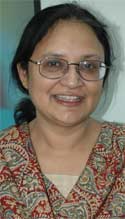 Our
host was Dr. Rukhsana Chowdhury
(photo to the left) is involved in a research project on ‘Effects
of environmental stress on the production of cell surface proteins and
of regulatory and virulence genes by gastrointestinal pathogens (Helicobacter
species) and by Lactic Acid Bacteria with relevance for the pathogenesis
of chronic infections as well as for applications in the food industry’,
which received a SASNET planning grant in February 2005. The main partner
in this project is the Department of Medical Microbiology,
Dermatology and Infection, Lund University, through Prof. Torkel
Wadström and Dr. Åsa Ljung.
Our
host was Dr. Rukhsana Chowdhury
(photo to the left) is involved in a research project on ‘Effects
of environmental stress on the production of cell surface proteins and
of regulatory and virulence genes by gastrointestinal pathogens (Helicobacter
species) and by Lactic Acid Bacteria with relevance for the pathogenesis
of chronic infections as well as for applications in the food industry’,
which received a SASNET planning grant in February 2005. The main partner
in this project is the Department of Medical Microbiology,
Dermatology and Infection, Lund University, through Prof. Torkel
Wadström and Dr. Åsa Ljung.
 After explaining
to us about her research and how they hope that they can develop a research
proposal for a 3-year funding, Rukshana introduced us to Prof. Siddharta
Roy, who is the Director of the Institute. A strong profile of the
Institute is research on poor people’s diseases like leishmaniasis
(called kalasar, black fever), which is a lethal and common disease among
poor people in Bihar, Jharkand and Orissa. They try to develop both a
curative drug for this, as well as a vaccine. Another strong interest
is in arsenic poisoning, which also affects poor people mostly. Finally,
there is also a great deal of research on various cancer forms. A particular
form called pancreas cancer has a high incidence in India.A ‘David’s
fight?’
After explaining
to us about her research and how they hope that they can develop a research
proposal for a 3-year funding, Rukshana introduced us to Prof. Siddharta
Roy, who is the Director of the Institute. A strong profile of the
Institute is research on poor people’s diseases like leishmaniasis
(called kalasar, black fever), which is a lethal and common disease among
poor people in Bihar, Jharkand and Orissa. They try to develop both a
curative drug for this, as well as a vaccine. Another strong interest
is in arsenic poisoning, which also affects poor people mostly. Finally,
there is also a great deal of research on various cancer forms. A particular
form called pancreas cancer has a high incidence in India.A ‘David’s
fight?’
Visit to the School of Environmental Studies at Jadavpur University
Web page: http://www.soesju.org/
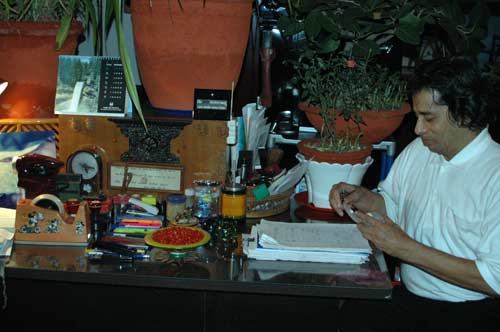 The
last visit for the day was the most interesting and engaging: The School
of Environmental Studies at Jadavpur University and meeting with Prof.
Dipankar Chakraborti (photo
to the right), Director and Head of the School. It is located within
the premises of the Dept. of Chemical Engineering at Jadavpur University
(dating back to 1921, thereby being one of the oldest departments in Chemical
Engineering in the World).
The
last visit for the day was the most interesting and engaging: The School
of Environmental Studies at Jadavpur University and meeting with Prof.
Dipankar Chakraborti (photo
to the right), Director and Head of the School. It is located within
the premises of the Dept. of Chemical Engineering at Jadavpur University
(dating back to 1921, thereby being one of the oldest departments in Chemical
Engineering in the World).
The building we entered was the usual rather shabby institution building,
but as we walked up the stairs and inside an atrium like building we saw
warm lights and flowers on the other side. Here Dipankar and his 20 co-workers
had created a small oasis – a pleasant working place with nice offices
and laboratories.
The research work at the School is focused on Arsenic Contamination in the Ganga-Meghna-Brahmaputra Plain (more information about this). They are carrying out field research in Bangladesh, West Bengal, Bihar, Assam and Uttar Pradesh. They started this work in 1988 and it has been an uphill struggle most of the time. When the first case of arsenic poisoning was discovered in UP in 1974, there was denial on part of the state government, a pattern that repeated itself well into the 1980s when more cases of poisoning were discovered all over the Northeast. As a result partners in this work are not always the government health institutions, in Bangladesh, for example, the partner is the Dhaka Community Hospital, run by an NGO.
 Since
1998 they are collaborating with GARG, the Groundwater
Arsenic Research Group at the Royal Institute of Technology, KTH (in
the Department of Land and Water Resources Engineering, contact person:
Prof. Prosun Bhattacharya).
Since
1998 they are collaborating with GARG, the Groundwater
Arsenic Research Group at the Royal Institute of Technology, KTH (in
the Department of Land and Water Resources Engineering, contact person:
Prof. Prosun Bhattacharya).
After a brief discussion, Dipankar showed us the film ‘Slow Poison
– III’, which they had made on the Arsenic problem and the
practical solutions they worked with.
Arsenic in the bore well water is the result of percolation of Himalayan
sediments which are found inside the ground all over the plains here.
When the tube reaches these layers, the arsenic is released into the water.
Use of bored tube wells are of recent origin in this region, since they
traditionally had access to abundant surface water. But this was a way
of avoiding the often severely polluted surface water as a source of drinking
water supply. Since arsenic poisoning has an incubation time of about
25 years, it took time for nature to hit back. So as regards water supply,
the villagers are now back on square one!
Meanwhile the current poisoning and continued use of arsenic contaminated
water is a ‘Goliath’ this team has made its cause of fighting.
There is also the question of the human ‘host’ – poor
underfed villagers are more susceptible to the effects of arsenic water.
There is the question of immediate care of these patients, who have developed
various skin ailments and open wounds.
Another thing is to use treatment plants to purify surface water, but
the state governments are of no help and the small plants, maybe costing
around Rs. 15-20 000 are mostly laying idle in the villages. There are
also other ways of overcoming the problem: digging of wells and rainwater
harvesting. Even tube wells can be used, if they are bored to reach thick
clay soil below 300 feet.
The Arsenic group has built a model village in West Bengal where they
demonstrate safe ways of solving the drinking and irrigation water problem.
They are studying the effects of arsenic water on various crops like paddy
and vegetables. Earlier indications that paddy is not affected may not
be true, in fact. They also study the effects on cattle when eating straw
grown on land irrigated with arsenic water.
At the entrance to Prof. Chakraborti’s laboratory there is board with the following words:
Nothing is easy – if you don’ want to do it
Nothing is difficult – if you want to do it
You have the power within you – you can do it
It is hard not to admire this charismatic researcher and activist. Dipankar had earlier spent 16 years as a researcher in Belgium and Texas, but felt a strong urge to return back home and take up this work. Moreover, he is not relying on outside funding for what they are doing. They take on consultancy work in the field wherever it is possible to charge a fee for the work they do. They save on laboratory equipment by finding and building their own cheap substitutes. One apparatus to measure arsenic content was a home made imitation of a 26 lakh foreign make, which had cost them only 6 lakh! We left rather shocked about the arsenic problem, but somehow also inspired.
Lars on a revisit to Jadavpur University, Kolkata, 5 January 2006
Web page: http://www.jadavpur.edu
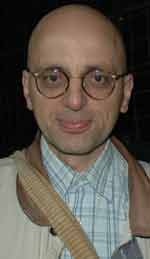 When
we visited Jadavpur University in Kolkata in mid-December we were accompanied
by the Swedish researcher Ferdinando
Sardella (photo to the right), PhD candidate at the Dept.
of Religious Studies, Göteborg University. He is working on project
exploring the ethics and social theory of Hindu mysticism, focusing on
Vaishnavism in Bengal during the early 20th century, carrying out fieldwork
in Kolkata. Therefore he was keen to become affiliated to a department
at Jadavpur University.
When
we visited Jadavpur University in Kolkata in mid-December we were accompanied
by the Swedish researcher Ferdinando
Sardella (photo to the right), PhD candidate at the Dept.
of Religious Studies, Göteborg University. He is working on project
exploring the ethics and social theory of Hindu mysticism, focusing on
Vaishnavism in Bengal during the early 20th century, carrying out fieldwork
in Kolkata. Therefore he was keen to become affiliated to a department
at Jadavpur University.
Our request about this got a positive response from the Dept. of Sociology,
and Dr. Asoke
Bhattacharya (our host during the December meeting) had again
called for a meeting with faculty members of the university on 5 January,
in order for Mr. Sardella to present himself and his project more in detail.
At the same time Dr. Bhattacharya requested Lars, still in Kolkata with
his family, to participate.
So after taking the beautiful Kolkata Metro underground railway from Belgachia in the northern part of the city, getting off at Kalighat station and from there proceed by taxi to Jadavpur, we reached the university campus. Dr. Bhattacharya met us and this time brought us the university guesthouse, where the meeting was to be held.
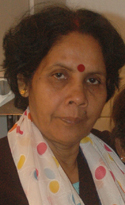 As it turned out the meeting turned out to be a continuation of the previous
SASNET information meeting, and less about Mr. Sardella’s affiliation.
The latter was left to a separate meeting afterwards between him and Dr.
Ruby Sain (photo to the
left) at the Dept. of Sociology. Instead it became a rewarding interactive
discussion on possibilities for individual researchers from various departments
at Jadavpur to find research partners at Swedish universities.
As it turned out the meeting turned out to be a continuation of the previous
SASNET information meeting, and less about Mr. Sardella’s affiliation.
The latter was left to a separate meeting afterwards between him and Dr.
Ruby Sain (photo to the
left) at the Dept. of Sociology. Instead it became a rewarding interactive
discussion on possibilities for individual researchers from various departments
at Jadavpur to find research partners at Swedish universities.
 |
| Dr. Parimal Karmakar and Prof. Subrata Pal, both from the Dept. of Biotechnology |
The faculty members invited to the meeting, representing different departments, presented their research interests and Lars gave advice regarding possible Swedish colleagues and/or departments to contact. A few of them we met already in December, but others had taken the opportunity to meet me this time. My last information folders about SASNET, brought from Sweden, were distributed.
Participants in the meeting:
• Dr. Asoke Bhattacharya, Adult and
Continuing Education and Extension Centre.
• Prof. Subrata Pal,
Dept. of Biotechnology. Dean of the Faculty of Science. Working on biodiversity
and gene replication.
• Dr. Parimal Karmakar,
Dept. of Biotechnology. Working on herbal drugs.
• Dr. Mridul Bose, Reader,
Dept. of Physics. Working on plasmaphysics, once planning for a joint
research project with Prof. Stenflo, Umeå University.
• Dr Ruby Sain, Dept. of Sociology.
Working on social and medical health, involved in a research project on
food habits among different ethnic groups in India.
• Prof. R Bandyopadhyay.
Head of department, Dept. of Mathematics.
• Prof. Tridib Chakraborty,
Dept. of International Relations. Working on studies of South East Asia.
SASNET - Swedish South Asian Studies Network/Lund
University
Address: Scheelevägen 15 D, SE-223 70 Lund, Sweden
Phone: +46 46 222 73 40
Webmaster: Lars Eklund
Last updated
2010-02-10
